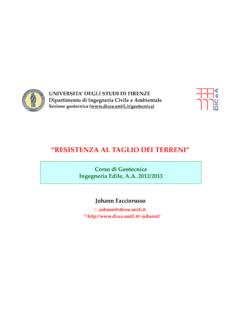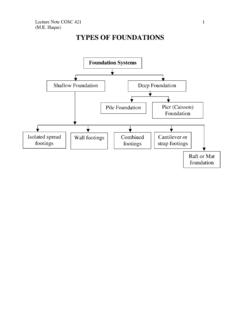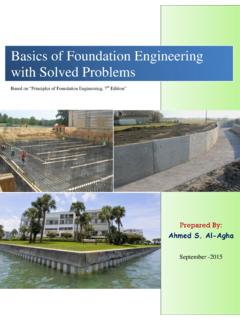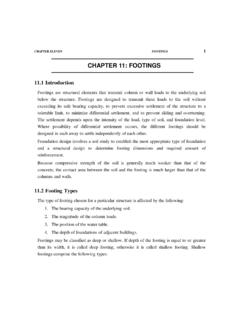Transcription of Basics of Foundation Design - UniFI
1 F Basics of Foundation Design Electronic Edition, January 2006 Bengt H. Fellenius Dr. Tech., P. Eng. Reference: Fellenius, , 2006. Basics of Foundation Design . Electronic Edition. , 275 p. Basics of Foundation Design Electronic Edition, January 2006 Bengt H. Fellenius Dr. Tech., P. Eng. 1905 Alexander Street SE Calgary, Alberta Canada, T2G 4J3 E-address: Web site: B A S I C S O F F O UN D A T I O N D E S I G N T A B L E O F C O N T E N T S 1.
2 Effective Stress and Stress Distribution (17 pages) Introduction Phase Parameters Soil Classification by Grain Size Effective Stress Stress Distribution Boussinesq Distribution Newmark Influence Chart Westergaard Distribution Example 2. Cone Penetration Testing (19 pages) Introduction Brief Survey of Soil Profiling Methods Begeman (1965) Sanglerat et al.
3 , (1974) Schmertmann (1978) Douglas and Olsen (1981) Vos (1982) Robertson et al., (1986)and Campanella and Robertson (1988) Robertson (1990) The Eslami-Fellenius CPTu Profiling and Classification Comparison between the Eslami-Fellenius and Robertson (1990) Methods Conclusions Additional Use of the CPT 3. Settlement of foundations (20 pages) Introduction Movement, Settlement, and Creep Linear Elastic Deformation Non-Linear Elastic Deformation The Janbu Tangent Modulus Approach General Cohesionless Soil, j > 0 Dense Coarse-Grained Soil, j = 1 Sandy or Silty Soil, j = Cohesive Soil, j = 0 Typical values of Modulus Number, m The Janbu Method vs.
4 Conventional Methods The Janbu Method compared to the e-lg(p) Method Time Dependent Settlement Creep Magnitude of Acceptable Settlement Calculation of Settlement Special Approach Block Analysis Determining the Modulus Number from In-Situ Tests In-Situ Plate Tests Determining the E-Modulus from CPT CPT Depth and Stress Adjustment Determination of the Modulus Number, m, from CPT 4. Vertical drains to accelerate settlement (13 pages) Introduction Conventional Approach to Dissipation and Consolidation Practical Aspects Influencing the Design of a Vertical Drain Project Drainage Blanket on the Ground Surface Effect of Winter Conditions Depth of Installation Width of Installation Effect of Pervious Horizontal Zones, Lenses.
5 And Layers Surcharging Stage Construction Normal Consolidation and Preconsolidation Pore Pressure Gradient and Artesian Flow Secondary Compression Monitoring and Instrumentation Sand Drains Wick Drains Definition Permeability of the Filter Jacket Discharge Capacity Microfolding and Crimping Handling on Site Axial Tensile Strength of the Drain Core Lateral Compression Strength of the Drain Core Smear Zone Site Investigation Spacing of Wick Drains Closing remarks 5.
6 Earth Stress (8 pages) Introduction The earth Stress Coefficient Active and Passive Earth Stress Surcharge, Line, and Strip Loads 6. Bearing Capacity of Shallow foundations (16 pages) Introduction The Bearing Capacity Formula The Factor of Safety Inclined and Eccentric Loads Inclination and Shape factors Overturning Sliding Combined Calculation of a Wall and Footing Numerical Example Words of Caution Aspects of Structural Design Limit States and Load and Resistance Factor Design Load factors in OHBDC (1991) and AASHTO (1992) Factors in OHBDC (1991) Factors in AASHTO (1992) 7.
7 Static Analysis of Pile Load Transfer (40 pages) Introduction Static Analysis Shaft and Toe Resistances Example Critical Depth Piled Raft and Piled Pad foundations Effect of Installation Residual Load Analysis of Capacity for Tapered Piles Factor-of-Safety Standard Penetration Test, SPT Cone Penetrometer Test, CPTU Schmertmann and Nottingham deRuiter and Beringen (Dutch) LCPC (French) Meyerhof Tumay and Fakhroo The ICP Eslami and Fellenius Comments on the Methods The Lambda Method Field Testing for Determining Axial Pile Capacity Installation Phase Structural Strength Settlement The Location of the Neutral Plane and Magnitude of the Drag Load Summary of Axial Design of Piles A few related comments Pile Spacing Design of Piles for Horizontal Loading Seismic Design of Lateral Pile Behavior Pile Testing Pile Jetting Pile Buckling 8.
8 Analysis of Results from the Static Loading Test (36 pages) Introduction Davisson Offset Limit Hansen Failure Load Chin-Kondner Extrapolation Decourt Extrapolation De Beer Yield Load The Creep Method Load at Maximum Curvature Factor of Safety Choice of Criterion Loading Test Simulation Determining Toe Movement Effect of Residual load Instrumented Tests The Osterberg Test Procedure for Determining Residual Load in an Instrumented Pile Modulus of Elasticity of the Instrumented Pile Tell Tale Instrumentation
9 Concluding Comments 9. Pile Dynamics (40 pages) Introduction Principles of Hammer Function and Performance Hammer Types Drop Hammers Air/Steam Hammers Diesel Hammers Direct-Drive Hammers Vibratory Hammers Basic Concepts Wave Equation Analysis of Pile Driving Hammer Selection by Means of Wave Equation Analysis Aspects to consider in reviewing results of wave equation analysis High-Strain Dynamic Testing of Piles with the Pile Driving Analyzer Wave Traces Transferred Energy
10 Movement Pile Integrity Integrity determined from high-strain testing Integrity determined from low-strain testing Case Method Estimate of Capacity CAPWAP determined pile capacity Results of a PDA Test Long Duration Impulse Testing Method The Statnamic and Fundex Methods 10. Piling Terminology (8 pages) 11. Specifications and Dispute Avoidance (8 pages) 12. Examples (21 pages) Introduction Stress Calculations Settlement Calculations Earth Pressure and Bearing Capacity of Retaining Walls Pile Capacity and Load-Transfer Analysis of Pile Loading Tests 12.








![Pile Foundation Design[1] - ITD](/cache/preview/7/1/b/5/4/9/2/e/thumb-71b5492ea36fbc0a87c29e49c6fa8bff.jpg)




